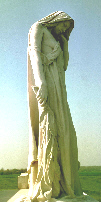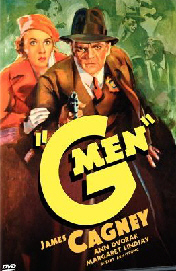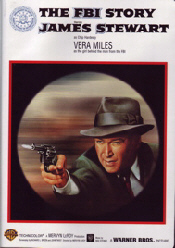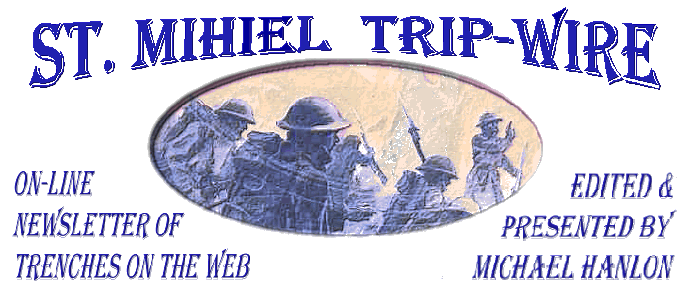
TRENCH REPORT: It's very rewarding to see material that premiered here on the Trip-Wire make its way into one of the latest history works on the war. Stuart Robson includes our feature on the "Three Ways to Recall the Great War" (article) as a supporting document in his second edition of The First World War published by Pearson Longman. Ruth Tenzer Feldman's book for younger readers, World War I: Chronicle of America's Wars, from Lerner Publishing references our article the "Origins of Doughboy" (article) Click
here to order Professor Robson's book and
here for Ms. Feldman's work. MH
This Month's Internet Focus:
Smithsonian Magazine Archives |
Smithsonian Magazine now has past articles available on-line, and a number of them have a WWI theme. The first on the list below should be read as a follow-up to Joanne Denison's review of The Crimson Portrait that we published in February:
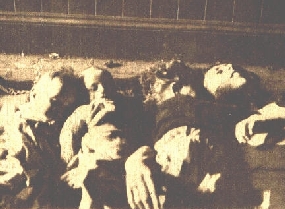
Infant Lusitania Victims Awaiting Burial
Queenstown, Ireland - May 1915
New at Our Own & Our Friends' Great War Websites
Click on Title to Access
|
New from Organizations
Auburn University Library holds the papers of ace and Medal of Honor recipient Capt. Eddie Rickenbacker of the 94th Aero Squadron. They are now accessible on-line.
At Great War Society Sites
|
I recently had some correspondence with Professor Bill Keylor of Boston University. His International History Institute is conducting in Boston a seminar on the Paris Peace Conference (March 23 & 24). (program information). I was reminded that his "Reassessment of the Peace Treaty" is simply one of the best articles we have published on any WWI subject. (Read the article.)
|
At the WFA-USA
|

Hiram Maxim and the Progenitor of
Most WWI Machine Guns (c. 1884)

The 27th Division [AEF] shoulder patch on the left contains a personal, phonetic tribute to the division's commander, MG John F. O'Ryan. Composed mostly off New York state National Guard formations, the insignia's main feature is a rounded "N" superimposed on a "Y". However, in the background can be seen the seven five-pointed stars of the constellation Orion. [Say it out loud, if you don't get it.]
Commemoration in France of the 1917 Battle of Vimy Ridge and the rededication of the newly renovated and restored Vimy Ridge Canadian Memorial will commence April 7th and run through April 9th over the Easter weekend.
|
| |
Charge of the Lancers
By Umberto Boccioni, 1915
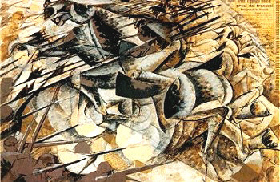
|
GREAT WAR 2007 EVENT CALENDAR
|
Double Ace Seminar
League of World War I
Aviation Historians
May 11-12, 2007
Holiday Inn Rosslyn in Arlington, VA (link)
|
90th Anniversary
Palestine Campaign
International Conference
September 3-6, 2007
Tel-Hai Academic College in Upper Galilee, Israel (email for details)
|
What We Fought
Each Other For
WFA-USA
18th National Seminar
September 7-9, 2007
Naval War College Newport, RI (Full Program)
|
T. E. Lawrence: A Symposium
The Huntington Library,
October 5-6, 2007
San Marino, CA (email for info.)
|
International Society for First World War Studies
International Conference
October 18-20, 2007
Georgetown University, Wash., D.C. (link)
|
Western Front Association
US Branch Chapter Meetings
Check for Your Region
Regularly Updated (details)
|
Great War Society Monthly Chapter Meetings
Berkeley, San Francisco and Palo Alto, CA
Regularly Updated (details)
|
Send additions/corrections:
Email Response
|

Memorable Event
|
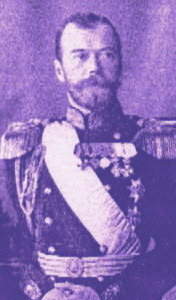
Tsar Nicholas II
Abdicates
March 15, 1917
Click on Image for More Information
|
|
Trip-Wire contributor Tom Phelan, author of the WWI novel, The Canal Bridge, will be on a speaking tour in New York state March - July. Visit his website for Tom's speaking schedule. (schedule)
Two classic WWI movies, Lawrence of Arabia and The Lighthorsemen make no reference to each other's stories. But now the Australian War Memorial is correcting matters. Visit their Lawrence/ Lighthorsemen Blog to catch up with their project. (link)
Do you know the way to San Jose? Saturday afternoon, March 3rd, 1-5 pm, The Burdick Military History Project at San Jose State University will be presenting a program on WWI and WWII topics, including Campus Conflict and ROTC during the wars, and the Japanese Internment. The program will be held in Engineering Auditorium (ENG 189) on the main campus. The late Charles Burdick was a distinguished historian and a founding member of the Great War Society.
| From Another Phonetic Front: Nurse Edith Cavell's last name rhymes with "gavel".
|

History is fascinated with how wars start, but history is made by how wars are ended.
Mr. Geraldo Rivera, February 9, 2007.
|
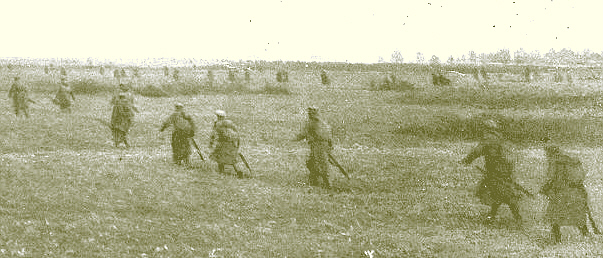
Russian Troops Advancing During Opening of Brusilov Offensive
June 1916
|
|
Subscribe to Our New On-Line Magazine
|
|
|

|
|
|
|
Page Two
|
Antonio Pierro, America's oldest veteran at age 110, died February 8th in Salem, Massachusetts. An Italian immigrant, he declined fighting for Italy in favor of his adopted country and served with the AEF as an artilleryman. (link)
Victor "Lloyd" Clemett, Canadian veteran who was placed in the Forestry Corps because of his youth, but who later volunteered for the front line during the 1918 crisis, died at the age of 107. (link)
Howard V. Ramsey, last WWI veteran of the state of Oregon, died February 22nd at age 108. He was declined for enlistment at first for being under weight, but after stuffing himself with bananas and water managed to pass the army physical. He drove a truck in France and was on the battlefield at the moment of the Armistice.(link)
|
By High-Speed Train to the Battlefields
By Christina Holstein
On 10 June this year the TGV Est, or high-speed train from Paris to eastern France, will stop for the first time at the new station at Issoncourt to the south of Verdun. The journey from Paris to Issoncourt will take 55 minutes, which should make it easier for visitors who wish to visit the battlefields by train. At the moment the timetable is still provisional, but it appears that on weekdays it will be possible to arrive by train from Paris in the early evening and to return during the morning, afternoon or evening on a subsequent day. As for morning arrivals, it looks as if the only possibility will be on Saturdays, and, with a return before 4.30 pm, that won't leave time for a day trip to Verdun.

The New Station
The official name of the new station is Meuse-Voie Sacrée and it stands on the great arterial road of the same name that supplied the Battle of Verdun in 1916. Built almost entirely of wood to reflect the rural nature of the Meuse region, it is, with its two wings and central tower, vaguely reminiscent of the Douaumont Ossuary, the memorial to the men of Verdun who have no known grave. Since it is, however, twenty-four kilometres south of Verdun and without transport to and from the city, the TGV will not be of much use to visitors. Unfortunately, I have so far been unable to find out what sort of shuttle service will be arranged or who will organise it.

TGV Est Train
The route to Verdun will take visitors through many historic areas, including Souilly, where the Mairie, or Town Hall, was used by General Pétain during 1916 and by General Pershing during 1918. I hope that by the time the first train stops at Issoncourt in June I shall have been able to provide details and a timetable.
|
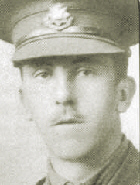 |
Soccer Balls at the Somme?
One of the enduring traditions of the First World War is that some British troops went over the top on the first day of the Somme (July 1, 1916), enthusiastically kicking soccer [or rugby?] footballs toward the German lines. One verified case of this is that of the men of the East Surrey Regiment [18th Division] commanded by Capt. W.P. Nevill [L]. He promised a reward to the first platoon scoring a goal against the Germans. One of the footballs Capt. Nevill provided is on display at the East Surrey's museum[R] at Guildford, Surrey. Nevill did not survive the day and is buried at Carnoy Cemetery on the Albert-Peronne Road. |
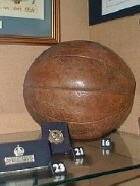 |

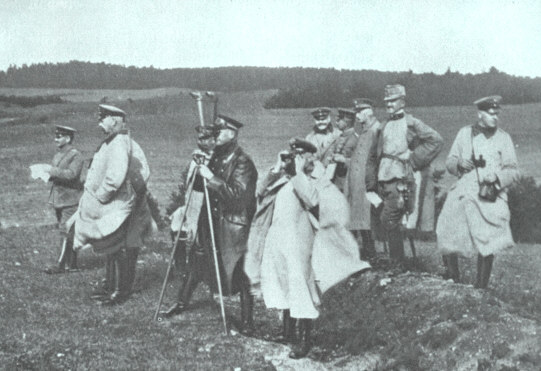
Hindenburg and Staff at Tannenberg Battlefield
(Possibly Ludendorff Behind Hand-Held Binoculars)
Click Here to Visit War in a Different Light
|

|
1917 on The Western Front
March
Planning Continues
|
The month of March was a time of increasing pressure on Nivelle from the politicians, who were becoming ever more demanding in their questioning regarding the possibility of success of his offensive. In addition, he had to contend with a rising wave of discontent and strikes, willfully stirred by various ultra left-wing newspapers and by sedition from underground newspapers. One of these newspapers was called Le Bonnet Rouge, edited by an anarchist who chose to call himself "Almereyda", a very close associate of Monsieur Caillaux, who had been Minister of Finance in previous governments. These events were allowed to continue without hindrance by the Minister of the Interior, Monsieur Malvy and by general vacillation by the government. Nivelle was powerless to stop these malcontents spreading grave dissent during his tenure of office as head of the army, and it was not until the advent of Georges Clemenceau in 1918 that the rot was stopped. (I recommend to readers a book from 1962 entitled Dare Call It Treason, written by Richard M. Watt, which in my opinion is the finest book I know about French politics during these years and is a fascinating read; boring it is not!!)
Since January the Germans had been withdrawing generally eastward away from the desolation of the Somme battlefield, while the British followed them up, hampered by the general mud and rubbish of the apocalyptic battlefield, a German scorched-earth policy that destroyed everything left. Even the remaining trees were cut down, all the wells were poisoned, and plentiful booby traps were left behind.
|
By the end of March the British were in their new positions facing the new unbroken Hindenburg Line thought by the defending Germans to be impregnable.
Map Showing Plan for Nivelle Offensive
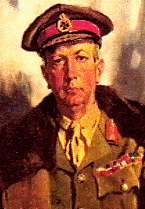
Sir Arthur Currie |
On the British front General Currie was organizing his Vimy attack with four Canadian divisions and making a superb job of it. He was not prepared to allow his troops to move until he was ready and could be assured that his artillery was spot-on against the dug-in German artillery, a lot of which was sheltered by concrete bunkers which often still exist. His troops were clear what their objectives were, and the Royal Flying Corps had gained control of the skies over Vimy. Inter-services cooperation was at a premium, and all staff officers were aware of this requirement. The German garrison on the ridge believed that it could not be taken because the French had been tried and failed for two years, but they were to be out-maneuvered by the planning of General Currie.
Field Marshal Sir Douglas Haig was not aware of the problems of General Nivelle, and he now waited for the two offensives to begin. Within the French ranks, all the troops waited for the final offensive to start, which they had been promised would bring an early end to the war.
The stage was set.
|
|
If you are travelling to Europe and would like to visit these fields of memory for a detailed tour, please contact experienced guides Tony Noyes or Christina Holstein at Verdun Tours
|
|

|
Long Boy: A Forgotten Musical Gem
From Robin Clayton
Radio Station WLRC, Walnut, Mississippi
|
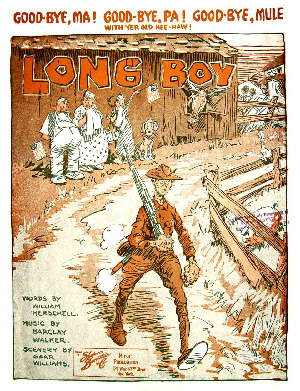 |
He was just a long, lean country gink
From way out West where the hop-toads wink;
He was six feet two in his stocking' feet,
An' kept a gittin thinner th' more he'd eat.
But he was as brave as he was thin,
When th' war broke out he got right in.
Unhitched his plow and put th' mule away,
Then th' old folks heard him say: --
Good-by, Ma! Good-by, Pa! Good-by,
Mule, with yer old hee-haw!
I may not know what th' war's about,
But you bet, by gosh, I'll soon find out.
An' O my sweetheart don't you fear,
I'll bring you a King fer a souvenir;
I'll git you a Turk an' a Kaiser, too,
An' that's about all one feller could do!
|
|
|
Page Three
|
 |
AN ACE MINUS ONE
By Timothy M. Morrisroe
Reviewed by Donna Cunningham
|
An Ace Minus One is a World War I novel that takes its hero from humble roots in the Midwest through major events of the Great War and its aftermath. In the process, Jack Elliot matures from an innocent youth to a seasoned veteran. The book begins with Jack in his 90s, residing in a nursing home and demanding to be interviewed by a hard-boiled San Francisco newspaper reporter. The old man claims to be a surviving World War I pilot. The reporter is skeptical but listens as the old man tells his story.
Jack Elliot is born in Eleveth, Minnesota and is raised on a farm by a Norwegian father and a French-Canadian mother. As a young boy, Jack does chores and familiarizes himself with the Model T, but his life changes when he is 14. He drives friends to a brothel, where he accidentally kills a man. To avoid being charged with murder, he flees to North Carolina to work on a relative's farm. After learning about the Great War, he joins the Merchant Marine and is assigned to a ship taking mules to England. Jack has the inglorious task of cleaning the mules' stalls. Once in England, he volunteers to drive an ambulance in France and is accepted because he speaks French and is familiar with the Model T. Jack sees trench warfare firsthand in Verdun, where he evacuates the wounded. When he learns that the French are looking for men to train as pilots, he volunteers and is accepted by the Foreign Legion.
Jack is trained as a pilot and flies in the Lafayette Escadrille. In 1916, Americans volunteered to fly combat missions under French officers. Tales of Jack's training and flying exploits are the heart of the novel. Jack wrestles with touchy mechanical problems, tries not to shoot off his own propeller, makes sure he keeps his bearings so he is not lost behind enemy lines, all the while searching for enemy planes to shoot down before they hit him first.
When the Americans enter the war, Jack becomes an officer in the American Air Corps. His goal is to become an ace. Having fallen in love with a French girl, he thinks being a decorated hero will impress her and make it possible to return to Minnesota when the war is over. Jack survives air battles, crashes, and being taken prisoner. When the war ends, Jack's life takes unexpected turns. He flies missions in North Africa, and spends the World War II years in Normandy.

Lufbery |
The narrative is interrupted from time to time by the efforts of the skeptical reporter to validate Jack's story. These interludes mirror the reader's dilemma. Jack's many encounters with famous people in France like Raoul Lufbery and Quentin Roosevelt arouse suspicion that his tale is fabricated. But as the story unfolds, it is so compelling that the reporter, his research assistant (and the reader) cast doubts aside and continue to follow the story to its bittersweet conclusion.
An Ace Minus One covers many of the events of World War I, bringing to life what it must have been like to be in France during the years of the Great War. The descriptions of the flying missions are compelling, described in vivid detail by the author, who was himself a U.S. Air Force pilot. While it is tempting to recommend the book to young people who might identify with its teenage hero, An Ace Minus One graphically portrays the brutality of war, making the novel more suitable for mature readers. A companion website, www.anaceminusone.com offers historical background and pictures of people and planes described in the book.
From iUniverse, 2006, 610 pages.
First of Two Parts
Next Month Donna Cunningham Interviews Author Jack Morrisroe
James McConnell, Real-Life Member of the Lafayette Escadrille
James Rogers McConnell was one of the original seven American pilots of the Lafayette Escadrille. Earlier he had served as a volunteer ambulance driver but chose later to play a role as a combatant. On March 19, 1917, he was the last member of the squadron killed while flying under French colors. His death inspired Gutzon Borglum's sculpture The Aviator at the University of Virginia, which McConnell attended before the war. Read his memoir, Flying for France, at the Gutenberg Project (link)
|
|
World War I Headlines
in the
21st Century
|
|
 |
The Emergence of the FBI
in Film
By Andrew Melomet
|
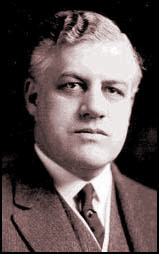
A. Mitchell Palmer |

J. Edgar Hoover, 1924 |
The Federal Bureau of Investigation has roots in the Great War and its immediate aftermath. J. Edgar Hoover was the original director, serving for 49 years. During World War I, Hoover worked for the Justice Department and eventually led the Enemy Aliens Registration Section. In 1919, he headed up the General Intelligence Division at the Justice Department. This division collected and maintained the database of names that was used in the Palmer Raids against suspected radicals, anarchists and leftists. [See link to Smithsonian Magazine article above.] Hoover joined the Bureau of Investigation as deputy head in 1921. In 1924 he was made acting director and was appointed director by President Calvin Coolidge on May 10 of that year. The Bureau of Investigation established a Technical Laboratory in 1932 and became the Federal Bureau of Investigation in 1935.
With the passing of Prohibition in 1919, bootleggers became well-known to the American public and were looked upon as a necessary evil for those citizens who enjoyed alcoholic beverages. They were regarded with a degree of ambivalence by many. Even bank robbers had a certain amount of public sympathy. But those 1930s gangsters and bandits involved in murder, vice and kidnapping were hated and feared by the general public. The FBI's official website calls 1921-1933 the "lawless years" because of gangsterism and the public disregard for Prohibition.
In July 1934 the Production Code for films took effect with Joseph Breen in charge. This meant no more sympathetic gangsters posing a problem for Warner Brothers, a studio that had James Cagney, Edward G. Robinson and Paul Muni under contract and which routinely released gangster and crime dramas. But, once the 1934 Omnibus Crime Bill was signed by Franklin Delano Roosevelt, the FBI acquired a national identity and allowed its agents to carry guns. The solution was evident--turn those dynamic actors from gangsters into crime fighters, making the movie protagonists law enforcement figures rather than criminals. Warners had a well-deserved reputation for making hard-hitting topical dramas: I Am A Fugitive From A Chain Gang (1932), Five Star Final (1931), The Public Enemy (1931), Little Caesar (1930), Wild Boys of the Road (1933), etc.
For years, Hoover had resisted involving himself in Hollywood productions. He felt that movies glorified crimes and criminals. But Hoover was friendly with the Warner brothers. However, in keeping with the Bureau's distrust of things Jewish and intellectual, neither Paul Muni nor Edward G. Robinson, both under contract, were in the cast.
In 1935 Warner Brothers released "G" Men, starring James Cagney. The original story by Darryl F. Zanuck was nominated as a write-in candidate for an Academy Award for Best Original Story. The screenplay was by Seton I. Miller, who also wrote The Fighting 69th (1940). The ad copy proclaimed "Public Enemy Becomes Soldier of the Law!" Cagney plays "Brick" Davis, a former "gutter rat" put through college, graduate school and law school by a benevolent bootlegger who joins the FBI after the murder of his college friend, now an FBI agent, by gangsters. In a brisk 86 minutes, it covers his training and fictionally portrays two "ripped from the headlines" events well-known to contemporary movie audiences- the infamous Kansas City Massacre of agents and local police and the shoot out at the Little Bohemia Lodge with the Dillinger gang. All of Cagney's energetic appeal and vivacity is evident on the screen, and despite an occasionally clichéd script the picture is tremendously entertaining. And violent enough to be banned in Chicago! The film was very successful and launched a new cycle of crime fighting films. It can be seen as the direct ancestor of police procedural dramas with its insider's look at training and scientific crime solving techniques. The New York Times called "G" Men a "blazing melodrama" with "the headiest dose of gun play that Hollywood has unloosed in recent months." Variety called it "red hot off the front page."
Originally produced without the cooperation of the FBI, "G" Men was so successful (grossing over $1,000,000 during the Great Depression) that it was reissued in 1949 on the FBI's 25th anniversary. A newly added prologue featured the film being shown to new FBI agents as a training tool! The director, William Keighley, won the Bureau's trust with the success of "G" Men and would direct another FBI picture, The Street With No Name (1948).
The Giannini brothers of Bank of America provided financial backing for the studio. The financial and personal closeness between the immigrant Italians and immigrant German Jews may account for the studio's propensity for portraying the majority of gangsters as Irish as opposed to Italian! (Other than Little Caesar (1930), which was based on a novel by W.R. Burnett.)
The FBI Story (1959) was directed by Mervyn LeRoy (Little Caesar, Five Star Final, I Am A Fugitive From A Chain Gang) and starred James Stewart. It follows the life of fictional career FBI agent "Chip" Hardesty from 1924 through 1959 (the Bureau's 35th anniversary). Hardesty takes on the Ku Klux Klan, Osage Indian murders, public enemies, Nazis and Communists. Several of the incidents in "G" Men are recreated in this widescreen, color production. The production design by John Beckman and the cinematography by Joseph F. Biroc are well done. The post-World War II sequence involving Soviet spies features location filming in New York City that now appears as a cinematic time capsule. The primarily subdued color palette used through the course of the film suddenly finds splashes of red cropping up as the Feds trail the spies. Hoover was personally involved in the production. He had approval over the producer, director, screenwriters, screenplay, the final film and the use of the Bureau's name in the advertising. Hoover appeared as himself in a sequence and was also responsible for causing extensive reshooting of scenes because he didn't care for the politics of several extras. The FBI Story was based on the book by Don Whitehead. Whitehead had a distinguished career as a war correspondent and Pulitzer Prize-winning reporter.
"G" Men and The FBI Story are available on DVD from Warner Home Video. The FBI Story is widescreen and comes with just a trailer. "G" Men includes a Warner Night at the Movies 1935 Short Subjects Gallery with newsreel clips, a comedy short, a classic cartoon and trailers. There's a new featurette, Morality and the Code: A How-To Manual for Hollywood, an audio commentary by film historian Richard Jewell, a Bobby Jones golf short and a 1935 studio blooper reel. Both releases look and sound great.
Andrew Melomet, Proprietor of Andy's Nickelodeon, will answer your Great War film or video inquiry. He is also soliciting your recommendations for the WWI Filmography he is compiling for our readers. Just click HERE.
|
|
| The following are thanked for their contributions to this issue of the Trip-Wire: Gena Rollins, Terry McGill, Robin Clayton, Tony Langley, Christina Holstein, Tony Noyes, Andy Melomet, Kimball Worcester, and Len Shurtleff. Mr. Rivera's comments were heard by me on the Sean Hannity radio show. Until next month, your editor, Mike Hanlon. |
SUBSCRIBE TO THE TRIP-WIRE
(Or send it to a friend.)
(Or send us a comment on the TRIP-WIRE)
CLICK HERE TO CONTACT US VIA EMAIL |
For further information on the events of 1914-1918
and membership information visit the Directory Pages of:
|
| |





